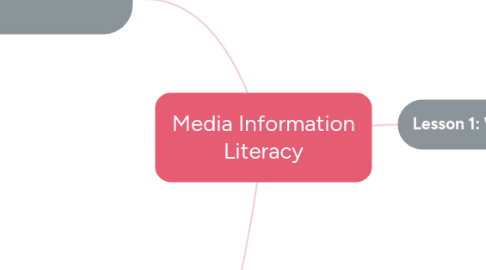
1. Lesson 2: Media Then and Now
1.1. Brief History of Social Media
1.1.1. Convey information they want to share
1.1.2. Get the information they also need
1.2. Evolution of Media
1.2.1. The Pre- Industrial Age
1.2.1.1. Chauvet Cave Writings
1.2.1.2. Clay & Stone Tablets
1.2.1.3. Printing process on wood blocks
1.2.2. The Industrial Age
1.2.2.1. Printing Press
1.2.2.2. Newspaper
1.2.2.3. Printed Pamphlets
1.2.2.4. Telegraph
1.2.2.5. Printer
1.2.3. The Electronic Age
1.2.3.1. Fax Machines
1.2.3.2. Cellular Phones
1.2.3.3. TV
1.2.3.4. Personal Computer
1.2.3.5. “Information Society”
1.2.4. The Digital Age
1.3. -
2. Lesson 3: Understanding Media: Aesthetic of Image,Text & Audio
2.1. Framing & Reading
2.1.1. Newspaper and Journalism
2.1.1.1. Newspaper — regularly scheduled publication containing news/information/advertising
2.1.1.1.1. Tabloids
2.1.1.1.2. Broadsheets
2.1.1.2. Journalism —Collecting/Writing/Editing/Presenting of news in newspaper etc.
2.1.1.2.1. SF Chronicles: The airbnb effect
2.1.1.2.2. The Guardian: NSA files recorded
2.1.2. Books, Comics, Magazines and the Publishing Industry
2.1.2.1. Books — Various formats/ structure in relaying information
2.1.2.1.1. Twighlight
2.1.2.1.2. The Fault in our Stars
2.1.2.2. Comics — designed into panels and visual drawing are similar to TV shows/movies.
2.1.2.2.1. The Batman Adventures: The Little Red Book
2.1.2.2.2. Age of Reptiles
2.1.2.3. Magazines — Has a regular schedule when it comes out.
2.1.2.3.1. Harper’s Bazaar Magazine
2.1.2.3.2. Time Magazine
2.1.3. Photography and Timeless Image Concepts
2.1.3.1. Photography
2.1.3.1.1. Process of recording images through chemical reaction.
2.2. Framing & Listening
2.2.1. Radio and Evoking Imagination
2.2.1.1. Has the ability to leave something to the listener’s imagination.
2.2.1.2. Illiterate people can listen as well as understand the content.
3. Lesson 1: What is Media?
3.1. Defining Media
3.1.1. How people spread information in different forms & devices
3.1.2. medium of communication (such as newspapers, radio, or television) that is designed to reach the mass of the people
3.2. Communication Process
3.2.1. From a sender, a message is delivered using a channel to reach the receiver.
3.3. Feedback Mechanism
3.3.1. Shannon-Weaver Model of Communucation
3.3.2. Tells us how the message was effective
3.4. Media as an Information Industry
3.4.1. Film Industry
3.4.2. Broadcast Industry
3.4.3. Publishing Industry
3.4.4. Photography Industry
3.5. Media as a Culture of Entertainment
3.5.1. Culture
3.5.1.1. Sum of characteristics that identify & differenciate human societies
3.5.2. Pop Culture
3.5.2.1. High Cultural or High Art
3.5.2.2. Low Brow
3.6. Kinds of Media
3.6.1. Traditional Media
3.6.1.1. Written or Print
3.6.1.2. Mass Comunication
3.6.2. New Media
3.6.2.1. Mobile Technology
3.6.2.2. Also known as “Digital Media”
3.6.3. Social Media
3.6.3.1. Twitter
3.6.3.2. Facebook
3.6.3.3. Instagram
3.6.3.4. Mobile Communication Technology
3.6.4. Film or Cinema
3.6.4.1. Used to disseminate a piece of information to a large audience
3.6.5. Mobile & Communication Technology
3.6.5.1. Cellular Phones
3.6.5.1.1. Data
3.6.5.1.2. Internet
3.6.5.2. Tablets
3.6.5.2.1. Data
3.6.5.2.2. Internet

